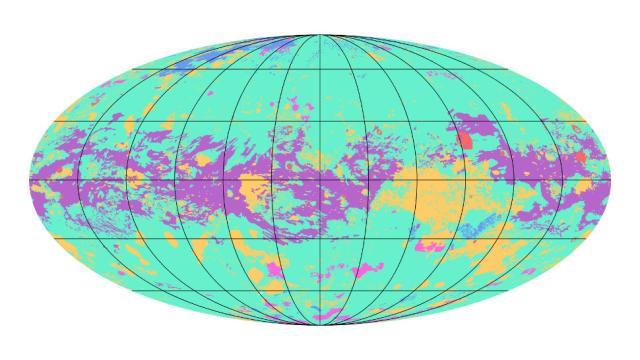Using data gathered by NASA’s Cassini probe, scientists have compiled the first global geologic map of Saturn’s enigmatic moon Titan. The new map reveals a world that’s distinctly familiar, yet completely foreign at the same time.
New research published this week in Nature Astronomy pierces through the murky haze of Titan’s atmosphere, providing our first global view of the moon’s complex and diverse landscape. The new map reveals vast plains, equatorial sand dunes, sprawling polar lakes, and a surprising paucity of impact craters. But while the map offers an unprecedented view of Titan, the study is raising some important new questions about Titan’s bizarre geology.
Titan—Saturn’s largest moon—is one of the most fascinating objects in the solar system. The moon has a dense atmosphere that prevents us from seeing its surface, and it’s the only other celestial object in the solar system aside from Earth that’s able to support stable liquid on the surface. On Earth, that liquid is water, but on Titan it’s liquid methane and ethane. These compounds are typically known as gases, but on Titan they assume a liquid form owing to the cold temperatures. Incredibly, methane and ethane rain down onto the surface, creating a dynamic array of features, including streams and lakes.
[referenced url=” thumb=” title=” excerpt=”]
The new study, led by planetary geologist Rosaly Lopes from NASA’s Jet Propulsion Laboratory, offers the first complete global map of these geological features, showcasing the moon’s many lakes, dunes, plains, craters, and other landmarks.
Michael Malaska, a planetary scientist from NASA’s Planetary Ices Group and the second author of the new study, is attracted to Titan as an object of scientific curiosity, he said, simply because it is so different.
“It has landscapes that look a lot like Earth, but all the materials are very different,” wrote Malaska in an email to Gizmodo. “Methane rain! Organic dunes! It’s fun to compare and contrast between Earth and Titan.”
To create the map, the team assembled infrared and radar data collected by NASA’s Cassini probe from 2004 to 2017, during which time the spacecraft performed 120 flybys of Titan. The researchers analysed and meticulously stitched together this data, allowing them to reconstruct the moon’s surface. While Titan is merely a moon, it’s as large as the planet Mercury, so there’s plenty to see here.
Six major geological forms were described in the new map: lakes, impact craters, sand dunes, hummocky (a fancy geological term for hilly regions with some mountains), labyrinths (tectonically torn regions), and plains.
A striking feature of Titan is that it lacks a common sight on other bodies: impact craters. This means something is changing “the surface fast enough to erase craters,” said Malaska. “If you look on the map you can see that there aren’t many craters at high latitudes.” The answer as to why, he said, isn’t immediately obvious.
“Also, Titan has a lot of organics,” he added. “Our work shows that organic molecules cover most of the surface—it is a world covered in organic chemistry!”
Titan is also “very plain,” said Malaska. Sure, the moon’s methane lakes are cool, and they get a lot of attention, he said, but they don’t actually take up much of Titan’s overall surface. Titan’s skyscraper-sized dunes are also neat, but Malaska says “the real story” of Titan is in its plains, which make up most of the surface.
“The undifferentiated plains—the dominant plain unit—is really strange,” Malaska told Gizmodo. “They look pretty much featureless at the resolution of Cassini, but if we looked closer, what would they look like? Would they have rivers and streambeds? Would there be little dunes or ripples? Boulders? Cobbles? Sand? Dust?”
[referenced url=” thumb=” title=” excerpt=”]
Looking ahead, the researchers would very much like to know what these plains are made of, how they got there, and why they’re located mostly in the mid-latitudes.
Indeed, the new map makes it clear that latitude plays an important role in determining the moon’s geology. The youngest surface features are the dune fields that dominate Titan’s equatorial region, known as the Shangri-La Sand Sea, while lakes are concentrated at the poles. Geological features known as labyrinths—areas ripped by tectonic activity—also appear closer to the poles. The widespread and nondescript plains, meanwhile, are located along the moon’s mid-latitudes. Malaska and his colleagues would like to know why certain features appear in some regions and not others. These are some “really good questions we can start thinking about,” he said.
It’s quite possible that many of Titan’s surface features are the result of its methane-based hydrologic cycle. Wet, humid conditions at the poles may foster the methane lakes, while the arid regions along the equator likely contribute to the formation of the extensive sand dunes.
No doubt, there’s still plenty of work to be done. For the new study, the researchers only managed to cover about 46 per cent of the moon’s surface, and at resolutions no better than 1 kilometre (0.6 miles). So Titan is still a gigantic science lab still waiting to be explored—and that’s exciting. Especially considering that NASA is sending an aerial drone to Titan, which is slated to arrive in the mid 2030s.
